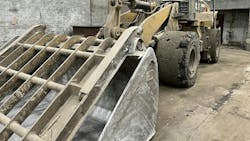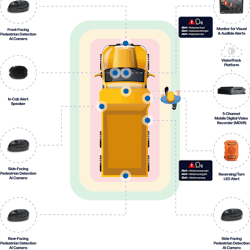With customers driving everything from semi-trucks to pickup trucks sharing tight spaces with heavy equipment in many of its facilities, the Los Angeles County Sanitation Districts has always been concerned with safety.
“The issue we’re trying to solve is with our equipment at solid waste facilities, material recovery stations, transfer stations, and landfills, is that we have busy medium-to-large machines close to customers at ground level,” says David Bolderoff, CEM, fleet manager.
How David Bolderoff achieves sustainability
“There are lots of blind spots as machines and customers move,” Bolderoff says. “One of the attachments we use on dozers is a 50-foot blade, so there are blind spots in front of that; same with some of the very large wheel loader buckets we use to push waste.”
Bolderoff was looking for a solution at Conexpo 2023 after checking out different technologies.
“We looked into vests with sensors,” he says. “That was good for employees but not practical for hundreds of customers per day. We also needed something that wasn’t going to register false readouts.”
Such readouts can be surprisingly common in landfills and other waste facilities. As an example, Bolderoff cited equipment running over a mattress, which could flip up or bounce, stopping equipment as if it sensed the movement of a person or another machine.
The Sanitation Districts settled on a pedestrian detection system with HD cameras and AI technology to “learn” objects. The system is from U.K.-based manufacturer VisionTrack.
“We did a pilot last year that was successful,” Bolderoff says. “It uses AI to sense objects or human beings, and we can set parameters out at 15 or 20 feet. Three hundred sixty-degree cameras give us visual and audio alerts.”
Learn how to integrate AI into specifications
The system is currently being implemented on the Districts’ off-road machinery operating near employees or customers at all facilities. Bolderoff thinks third-party systems are further along than many OEM systems, for the most part.
“There is LiDAR, radar, OEMs have all these different systems,” he says. “The biggest problem we have in the waste industry is running over objects all the time, backing up to walls, and confined spaces. That’s where the A.I. comes in.”
About the Author
Frank Raczon
Raczon’s writing career spans nearly 25 years, including magazine publishing and public relations work with some of the industry’s major equipment manufacturers. He has won numerous awards in his career, including nods from the Construction Writers Association, the Association of Equipment Manufacturers, and BtoB magazine. He is responsible for the magazine's Buying Files.


